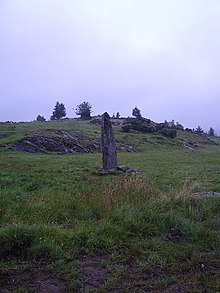Orust (municipality)
| Orust parish | |||||
|---|---|---|---|---|---|
|
|||||
| State : | Sweden | ||||
| Province (län): | Västra Götalands län | ||||
| Historical Province (landskap): | Bohuslan | ||||
| Main place: | Henån | ||||
| SCB code: | 1421 | ||||
| Residents : | 15,218 (December 31, 2019) | ||||
| Area : | 391 km² (January 1, 2016) | ||||
| Population density : | 38.9 inhabitants / km² | ||||
| Website : | www.orust.se | ||||
| List of municipalities in Sweden | |||||
Coordinates: 58 ° 11 ' N , 11 ° 42' E
Orust is a municipality ( Swedish kommun ) in the Swedish province of Västra Götalands län and the historic province of Bohuslän . The main town of the municipality is Henån .
The municipality consists of the island of Orust , on which most of the inhabitants live, and some surrounding, smaller islands and skerries , some of which are inhabited, such as Flatön , Lyrön , Härmanö , Gullholmen , Käringön and Malö .
geography
The island of Orust, which makes up most of the municipality, is connected to the mainland by two bridges and two ferries . It is the largest island on the Swedish west coast and is located about 50 km north of Gothenburg .
history
Orust was part of the Norwegian area of Viken in the 11th century . The word Vikings is said to be derived from “Viken”. In the following centuries the first Christian churches were built on Orust. In 1350, the plague epidemic, which was rampant in Sweden, wiped out 80% of the population. This led to a decline in agriculture . The island did not recover until the end of the 15th century, and the population rose again to 2,000.
The Reformation reached Orust in 1536. Wars and the construction of ships meant that the whole island was cleared by around 1650. After that, the forest recovered slightly, until the forest was cleared again from around 1750 due to an increase in population (construction and firewood) and the emerging fishing (building of ships). It was not until the herring swarms ceased to exist around 1810 that people turned to agriculture. With new techniques (iron plow ) more and more areas of the island could be used for agriculture. The land reform of 1827 also led to an increase in yield. This doubled the population from 1805 to 1880 to 18,129 people. This is the highest number of inhabitants that Orust has ever seen.
Tourism began at the end of the 19th century . In the 20th century, electrification ( electricity from 1910), traffic , trade and tourism brought about an economic boom. Although the population had decreased to 8,800 by 1968, the influx of people over the last few decades has increased the number of inhabitants again.
Industry
The area has always been shaped by fishing and boat building. Today the well-known local boat builders Hallberg-Rassy and Najadvarvet are the island's two largest employers.
places
Web links
- Official website (German)
Individual evidence
- ↑ Folkmängd i riket, län och kommuner December 31, 2019 at Statistiska centralbyrån
- ↑ Kommunarealer January 1, 2016 at Statistiska centralbyrån (including all inland waters)


